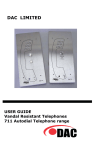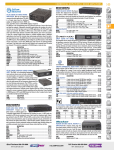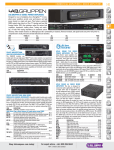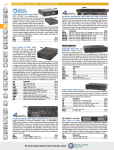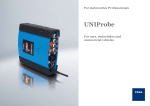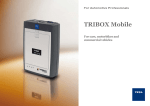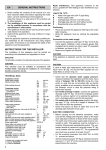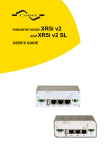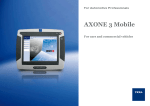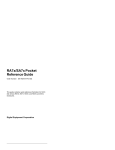Download DAC Limited 711 Series User guide
Transcript
DAC LIMITED ELECTRICAL INSTALLATION External Bell All bells must be approved for connection to the telephone netwrk. They are of the low frequency A.C. ~pe (15Hz-25Hz). D.C. versions must NOT be used. Connect to terminals 2 and 4 of the tag block. Ensure that DIP switch SW18 3 is set to '3 (ON)' enabling the internal bell capacitor if a master socket is NOT used. Call Restriction Timeout (used when 'CLEAR' key is not fitted) If this facility is enabled (SW18 -1 set to 'OFF') then each call will be time restricted to approximately 1 minute, in one of two ways, set by SW18 - 2. 1. Fixed - (SW18- 2 set to 'OFF') the 1 minute starts from the last press (and release) of the 'PRESS TO CALL' key or the service required. 2. Auto - (SW18 - 2 set to 'ON') the 1 minute starts from the end the last incoming tone or speech. Line Terminal Mode Selections Summary of mode selectable DIP switches:SW18-1 Timeout enable: SW18-2 1 minute timeout selection: SW18-3 Internal Bell capacitor (disabled when master socket is used) SW24-1 Loop Dial or DTMF Dial APPROVED for connection to telecommunication systems specified in the instructions for use subject to the conditions set out in them 12 Document No 552625 OFF - enable ON - disable (factory setting) OFF - fixed (factory setting) ON - automatic ON - enabled OFF - disabled (factory setting) Loop Dial- A (factory setting) DTMF- 1 USER GUIDE FOR RA711/1011, /1012 & /1013 VANDAL RESIST TELEPHONES DAC Limited Lomeshaye Business Village, Turner Road. Nelson. BB9 7DR Tel: +44(0) 1282 447000 Fax: +44 (0) 845 280 1915 Iss. 6 June 2005 Part No: 552625 Issue 6 1 ELECTRICAL INSTALLATION CONTENTS This guide is in two parts. The first part is provided for users of this instrument and the second part is for the sole use of your approved telephone installer. Line Terminal Connections and Selections DO NOT CONNECT THE LINE TERMINATIONS UNTIL PROGRAMMING-IS COMPLETE (see page 12). The number of telephones that can be connected to a direct exchange line or PBX extension is limited by the ringer equivalence number (REN) of all the telephones connected, this should not exceed a total value of 4. The REN value of this telephone is 1. In case of doubt consult your telephone supplier. Part 1 Part 2 General 3 The Terminal block mounted at the back of the unit is labelled as follows:- Approved Facilities 4 Operation 6 1. 2. Line (B) Bell mute / extension bell Installation 8 3. Not used 4. 5. Line (A) / extension bell 6. } } plug 431A External induction loop for Hearing Aid (3 turns, 1m dia) 7. 0 volt 8. +9 volt } external 9 volt dc supply For a 2-line installation connect 1 and 4. Programming of Autodial Keys Ensure that the telephone is disconnected from the telephone line and that the 9 volt power supply is connected and switched ON. DO NOT USE THE FRONT PANEL KEYS. To store telephone, numbers 'behind' the Autodial proceed as follows 2 11 1. Press 'ON', immediately followed by 'STORE'. 2. Press particular Autodial key to be programmed, 'S0', 'S1' or 'S2'. These keys are part of the group which include the 'STORE' and 'PAUSE'. Note that 'S0' corresponds to the top (EMERGENCY or PRESS TO CALL) front panel key, 'S1' to the middle and 'S2' to the bottom key. 3. Enter digits to be stored, (maximum 24). Include pauses as required for those exchanges that require you to wait for a second dial tone. 4 No digits will be sent to the telephone line. 5. Finish by pressing 'STORE' again, followed by 'CLEAR' if fitted on the front panel. 6. Reconnect the telephone to the line in accordance with the Line Connections shown above. 2 11 ELECTRICAL INSTALLATION GENERAL Electrical Connections The types of telephones covered by this guide are approved in the United Kingdom under the No. S/3064/3/N/502517 for connection to: The cables are passed through relevant conduit and connected (in the case of directly wired situations) to the tag block on the instrument. The telephone is to be earthed using the earthbonding point provided (see diagram). If the telephone is situated within electrified railway locations, other regulations regarding earthing of trackside equipment may apply e.g. BR specification No. 1686 (Para 5.2.4). Connect the 9 volt approved DC power supply, Pt.No. RA1050/1000, to terminals 7 and 8 and ensure that it is switched ON. The adjacent lamp will illuminate if connected correctly. If the external hearing aid induction loop is to be installed, connect to the terminal block in accordance with the connections below and mount vertically around the instrument. For versions /1011 and /1013 the Autodial keys have to be correctly programmed. The program memory requires power. This is supplied by the 9 volt power supply; loss of this power for a few minutes after disconnection will not cause memory loss and not at all if the line connection is made. It is not necessary to have the line connection in place during programming. • A direct exchange line (i.e. a line exclusive to the meter and not 'shared'); • To an extension of a direct exchange line; • To an extension on certain types of PBX. They are not suitable for use on party line installations or as extensions to a pay phone. Faciltities RA711/1011: 1 number and 'CLEAR' button RA711/1012: 2 numbers RA711/1012/C: 2 numbers and 'CLEAR' button (optional) RA711/1013: 3 number RA71 1/1013/C: 3 numbers and CLEAR, button (optional) Optional Extra Hearing Aid Induction loop RA1060/1000 10 3 APPROVED FACILITIES INSTALLATION This apparatus has been approved for use of the following facilities:- Wall Surface Installation 1 1. Fix the surface mounting back box to the wall, with cut-out at the bottom, using size 8 or 10 screws with rawplugs (4 off). Loudspeaking (no handset) hands-free operation. 2. Visual indication of 'off-hook' condition (line looped). 3. Audible and visual alarm indication of incoming calls. 4. Installation access using special tools only. 5. External mains to DC power supply (9 volts) supplied with each instrument, Part No. RA1050/1000. 6. Provision for external induction loop for hearing aid use, Part No. RA1060/I000. 7. Provision to introduce equivalent 'master socket' bell capacitor for directly wired applications, set by DIP switch on installation. 8. Provision to connect external extension bell. 9. Provision to enable automatic clear down of call loop, either fixed timeout or timeout after loss of incoming speech, approximately one minute. Set by DIP switch on installation, 10. Mounting flush to vertical surface, a back-box is provided utilising standard 20mm 'knock-outs' for cable access. An optional back-box for conventional surface (protruding) wall mounting is available 11. Up to three 'Autodial' keys initiate a fixed, pre-programmed, series of digits (24 digits maximum per key). 12. Selectable Loop Dial or DTMF dialling, set by DIP switch on installation. 13. Optional 'CLEAR' key on RA711/1012 and RA711/1013 where autocall clear-down is inconvenient 14. With a PBX with or without secondary dial tone. 2. Connect the cabling, as detailed under Electrical Connections, and then fit to the back box (as described under Wall Flush Installation, item 3). 3. Use any suitable silicone waterproofing sealant (such as Unibond Waterproof Flexible Frame Sealant) to seal to the back box. Leave a 12mm to 13mm (0.5") gap at the bottom for drainage. Top-of-pole Installation 1. Place the top-of-pole mounting over the top of the pole. 2. Tighten the grubscrews to secure the mounting. 3. Fix the surface mounting back-box to the top-of-pole mounting with the screws provided. 4. Connect the cabling, as detailed under Electrical Connections, and then fit to the back-box (as described under Wall Flush Installation, item 3). 4 9 INSTALLATION The following information is provided for use by the approved installer or telephone network supplier only. The RA711 telephone can be either wall mounted or top-of-pole mounted. Wall mounting can be surface, flush or inset into the wall. Various electrical options are available as defined under the Electrical Connections section. Make sure that these are set correctly before finally fitting the unit to the back box. Mark the removable insert with your telephone number, if desired. Wall Flush Installation 1. Produce hole in wall 285mm high 120mm wide 60mm deep. 2. Use size 8 or 10 screws with rawplugs (4 off) to fix back box into wall, with cut-out at the bottom 3. Connect the cabling, as detailed under the EIectricaI Connections section. Use a 4mm socket-head key, through the 4 small holes in the front plate, to fit the telephone unit to the back-box. Start each screw by turning several rotations at a time until all 4 screws are secure. To remove the telephone from the box reverse the procedure. 4. Use any suitable silicone waterproofing sealant (such as Unibond Waterproof Flexible Frame Sealant) to seal to the wall. Leave a 12mm to 13mm (0.5") gap at the bottom for drainage. APPROVED FACILITIES Any other usage will invalidate the approval of the apparatus if as a result it then ceases to comply with the standards against which the approval was granted. Connection is affected by plugging in to the appropriate line socket. If your telephone connection is not fitted with new style sockets contact your approved telephone installer or the telephone network supplier (using the reply card provided). If this method of connection is inadequate because, for example, the telephone is to be mounted outside where new sockets are not intended to be used, arrange for your telephone network supplier to directly connect the instrument (using the postcard provided). The telephone should operate correctly when connected to most compatible PBXs, including those that use secondary dialling tone. However, it cannot be guaranteed that the apparatus will operate under all possible conditions of connection. Any cases of difficulty should be referred in the first instance to your local supplier of the instrument The telephone is intended for use when powered by the 9 volt DC mains unit supplied. Other usage will invalidate any approval given to this apparatus if as a result it ceases to comply with BS 6301:1989. This apparatus is intended to be internally accessible for installation purposes only to authorized personnel and must be installed such that user access is prevented. Correct fitting and installation are mandatory as failure to prevent such user access will invalidate any approval given to this apparatus. 8 5 OPERATION - RA711/1011 OPERATION - RA711/1012 &/1013 To make a call To make a call Depress the 'PRESS TO CALL' key, dialling tone will NOT be heard. Depress the 'Autodial' key for the service required, dialling tone will NOT be heard. Dialling takes place automatically, including pauses. Dialling takes place automatically, including pauses. At the end of a call press 'CLEAR' or wait one minute for automatic cancellation of call. At end of call press 'CLEAR' or wait one minute for automatic cancellation of call. To answer a call To answer a call Depress the 'PRESS TO CALL' key (this will not initiate dialling whilst the telephone is being called). At the end of the call press 'CLEAR' or wait one minute for automatic cancellation of call. Depress any Autodial key (this will not initiate dialling whilst the telephone is being called). At end of call press 'CLEAR' or wait one minute for automatic cancellation of call. 6 7








